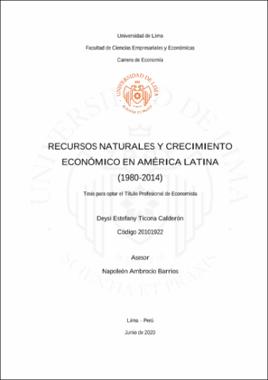| dc.contributor.advisor | Ambrocio Barrios, Napoleón | |
| dc.contributor.author | Ticona Calderón, Deysi Estefany | |
| dc.date.accessioned | 2020-07-31T19:37:25Z | |
| dc.date.available | 2020-07-31T19:37:25Z | |
| dc.date.issued | 2020 | |
| dc.identifier.citation | Ticona Calderón, D. E. (2020). Recursos naturales y crecimiento económico en América Latina (1980-2014) (Tesis para optar el Título Profesional de Economista). Universidad de Lima. | es_PE |
| dc.identifier.uri | https://hdl.handle.net/20.500.12724/11206 | |
| dc.description.abstract | Disparities in per capita income levels among economies around the world have motivated various investigations and approaches to model the behavior of economic growth in the long term. A pattern that has been evident among the countries poor in natural resources has been its pronounced economic growth in comparison to the countries rich in natural resources. In this context, the need arises to objectively evaluate the repercussions of dependence on natural resources in Latin American countries, in order to identify the variables that are directly affected by this dependency. The objective of this research is to analyze the impact of natural resources on the economic growth of 17 Latin American countries, using the Solow-Swan economic growth model as a theoretical basis, using the panel data estimation technique for the period 1980-2014 with a five-year periodicity, using the Generalized Least Squares (GLS) method. The variables used in this analysis were the Gross Domestic Product (GDP) per capita and initial per capita, fertility rate, aggregate investment, exports of natural resources, concentration of exports, institutional quality and the GDP gap. No evidence of negative correlation was found between the natural resources sector and the economic growth rate, therefore no evidence of the existence of the Dutch disease was found during the study period. It was also shown that the negative association between growth and natural resources is explained by the concentration of primary exports. Furthermore, the existence of conditional convergence between the sample countries was verified. This finding is robust, since after introducing the control variables, the level of significance and the sign of the convergence indicator did not change. Likewise, the speed of convergence found was 1.35%, close to the 1.41% obtained by De Gregorio & Lee (1999) for Latin American countries. Finally, it was shown that institutional quality negatively affects the relationship between the level of concentration of exports and economic growth. | en_EN |
| dc.description.abstract | Las disparidades en los niveles de renta per cápita entre las economías alrededor del mundo han motivado diversas investigaciones y enfoques a modelar el comportamiento del crecimiento económico en el largo plazo. Un patrón que se ha evidenciado entre los países pobres en recursos naturales ha sido su pronunciado crecimiento económico en relación a los países ricos en recursos naturales. En este contexto, nace la necesidad de evaluar de manera objetiva las repercusiones de la dependencia de los recursos naturales en los países de América Latina, a fin de identificar las variables que son directamente afectadas por esta dependencia. La presente investigación tiene como objetivo general analizar el impacto de los recursos naturales sobre el crecimiento económico de 17 países de América Latina, empleando como base teórica el modelo de crecimiento económico Solow-Swan, utilizando la técnica de estimación de datos de panel para el periodo 1980-2014 con periodicidad quinquenal, mediante el método de Mínimos Cuadrados Generalizados (MCG). Las variables empleadas en este análisis fueron el Producto Bruto Interno (PBI) per cápita y per cápita inicial, tasa de fertilidad, inversión agregada, exportaciones de recursos naturales, concentración de las exportaciones, calidad institucional y la brecha del PBI. No se encontró evidencia de correlación negativa entre el sector de recursos naturales y la tasa de crecimiento económico, que dé cuenta de la existencia de enfermedad holandesa durante el periodo de estudio. También se demostró que la asociación negativa entre crecimiento y recursos naturales es explicada por la concentración de exportaciones primarias. Además, se verificó la existencia de convergencia condicional entre los países de la muestra. Este hallazgo es robusto, ya que luego de introducir las variables de control, el nivel de significancia y el signo del indicador de convergencia no varió. Asimismo, la velocidad de convergencia hallada fue de 1.35%, cercano al 1.41% obtenido por De Gregorio & Lee (1999) para países de América Latina. Por último, se demostró que la calidad institucional incide negativamente en la relación entre el nivel de concentración de las exportaciones y el crecimiento económico. | es_PE |
| dc.description.uri | Tesis | |
| dc.format | application/pdf | |
| dc.language.iso | spa | |
| dc.publisher | Universidad de Lima | |
| dc.rights | info:eu-repo/semantics/openAccess | * |
| dc.rights.uri | https://creativecommons.org/licenses/by-nc-sa/4.0/ | * |
| dc.source | Repositorio Institucional - Ulima | es_PE |
| dc.source | Universidad de Lima | es_PE |
| dc.subject | Economic development | |
| dc.subject | Natural resources | |
| dc.subject | América Latina | |
| dc.subject | Desarrollo económico | es_PE |
| dc.subject | Recursos naturales | es_PE |
| dc.title | Recursos naturales y crecimiento económico en América Latina (1980-2014) | es_PE |
| dc.type | info:eu-repo/semantics/bachelorThesis | |
| thesis.degree.level | Título Profesional | es_PE |
| thesis.degree.discipline | Economía | es_PE |
| thesis.degree.grantor | Universidad de Lima. Facultad de Ciencias Empresariales y Económicas | es_PE |
| dc.publisher.country | PE | |
| dc.type.other | Tesis | |
| thesis.degree.name | Economista | es_PE |
| renati.advisor.orcid | https://orcid.org/0000-0001-8989-9232 | |
| renati.discipline | 311016 | |
| renati.author.dni | 47692451 | |
| renati.level | https://purl.org/pe-repo/renati/level#tituloProfesional | * |
| renati.advisor.dni | 06773027 | |
| renati.type | https://purl.org/pe-repo/renati/type#tesis | * |
| dc.subject.ocde | https://purl.org/pe-repo/ocde/ford#5.02.01 | |
| dc.identifier.doi | http://doi.org/10.26439/ulima.tesis/11206 | |
| ulima.cat | OI | |



